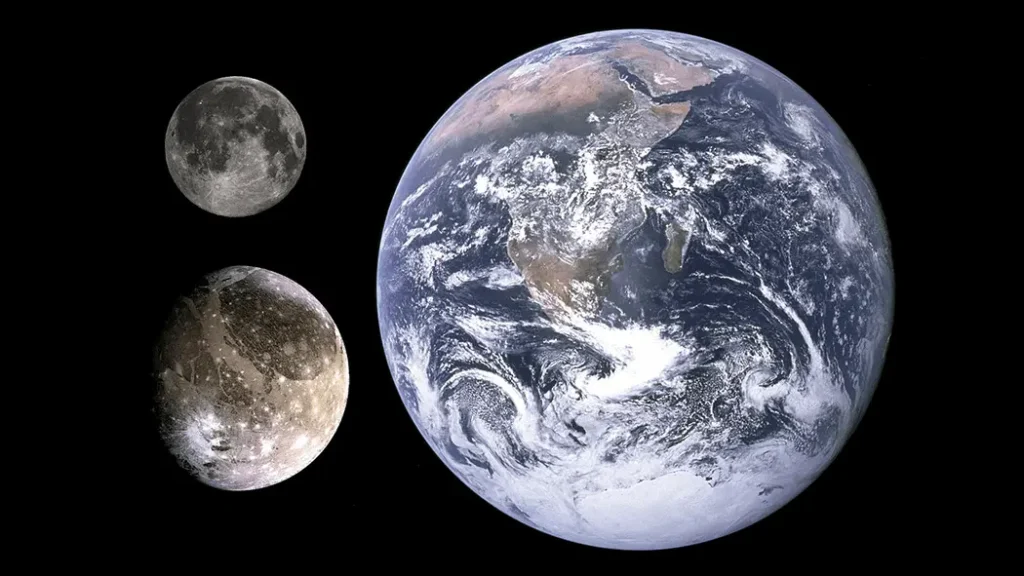When we think of moons, Earth’s glowing companion often comes to mind. But did you know that the largest moon, or satellite, in our solar system is far bigger and even more fascinating? The biggest satellite of the solar system is Ganymede, which revolves around Jupiter. This massive moon is not just larger than any other satellite. It is even bigger than Mercury, one of the planets in our solar system. It also has unique features that make it stand out among all moons. So, let us explore why Ganymede is such a fascinating moon and what makes it worth exploring.
What Is Ganymede?
Ganymede is one of the 95 moons that orbit Jupiter. Jupiter is the largest planet in our solar system. Ganymede was discovered by Galileo Galilei in 1610. He also discovered three other large moons of Jupiter: Io, Europa, and Callisto. These four moons are now called the Galilean moons. They are among the largest objects in the solar system that are not planets. Out of these, Ganymede is the biggest satellite of the solar system.
Is Ganymede a Moon or a Satellite?
You might wonder, is Ganymede a moon or a satellite? The answer is—both! In astronomy, the term satellite refers to any object that orbits around a planet. This can include man-made objects as well as natural ones. For example, man-made objects include communication satellites, while natural ones include moons.
When we talk about natural satellites, we mean objects like Ganymede. These objects were naturally formed in space and orbit a planet. In this case, that planet is Jupiter. Moon is just another way of saying natural satellite.
Ganymede is often called the largest moon of the solar system. However, it is also the biggest satellite. Both terms are correct. But ‘moon’ is more commonly used when discussing natural objects like Ganymede.
Just as Earth has its Moon, other planets in our solar system also have their own moons. In fact, there are 293 known moons around the planets in our solar system.
Interestingly, Mercury and Venus do not have any moons. In contrast, Saturn holds the record with 146 moons! Imagine looking up at the night sky on Saturn. You would see a breathtaking sight, with so many moons shining above.

In terms of size, the smallest moon is Deimos. It orbits Mars and is only about seven miles across. In contrast, the largest moon in our solar system is Ganymede, which orbits Jupiter.
How Big Is Ganymede?
Ganymede is massive! Its diameter is about 5,262 kilometers (3,270 miles), which makes it the largest moon of the solar system. To put it into perspective, Ganymede is even larger than Mercury, which is a planet! In fact, if Ganymede were orbiting the Sun instead of Jupiter, it could be classified as a planet. That is how big it is.
Ganymede Compared to Earth
When you compare Ganymede to Earth, its size and features become even more impressive. The diameter of Ganymede is about 41% of the diameter of Earth. While it is much smaller than our planet, it is still incredibly large for a moon.
However, when it comes to temperature, Ganymede is much colder than Earth. Daytime temperatures on Ganymede range from -297 to -171 degrees Fahrenheit. This is because Jupiter and its moons get less than 1/30th of the sunlight that Earth receives. Without a thick atmosphere to trap heat, Ganymede stays icy cold.
What If the Biggest Satellite of the Solar System Were Our Moon?
Imagine if Ganymede replaced our Moon. To give you an idea of its size, Ganymede is much larger than our Moon. In fact, it is about two times bigger in area. Now, if Ganymede were at the same distance from Earth as our Moon, it would dominate the night sky. It would look not only bigger but also much brighter. This is because Ganymede reflects light nearly four times better than our Moon. On a full moon night, it would almost feel like daylight!

Since the mass of Ganymede is two times that of the Moon, it would create much larger ocean tides. They would be double the size we experience now. That is a lot of extra movement in our seas! Ganymede’s large size has sparked interesting questions. For example, ‘Can Ganymede support life?’ and ‘Does Ganymede have water?
Can we consider Ganymede a planet?
As mentioned earlier, Ganymede is larger than Mercury. But does that make it a planet? Not quite. Ganymede lacks some features that planets have. For example, it does not have a direct orbit around the Sun. Instead, it orbits Jupiter. This means it is classified as a moon, or natural satellite.
Unique Atmosphere and Gravity of Ganymede
Even though Ganymede is bigger than Mercury, its gravity is much weaker. This is because Ganymede is mostly made of ice and rock. In contrast, Mercury is a dense planet made of heavier materials like iron. So, even with Ganymede’s larger size, its lower density means it has a weaker pull. If you stood on Ganymede, you would weigh a lot less than on Mercury!
What is even more surprising is Ganymede’s thin atmosphere. It is mostly made of oxygen. Researchers believe that the oxygen is actually coming from Ganymede’s icy surface. This adds another layer of intrigue to this massive moon. But don’t get your hopes up—it’s far too thin to support human life. Despite this, Ganymede’s atmosphere and fascinating features continue to capture the interest of space scientists.
Does Ganymede Have Water?
Ganymede is not only the largest satellite of the solar system. It also holds another fascinating secret. Beneath its icy surface, Ganymede is believed to have an internal ocean. In fact, this ocean might hold more water than all of Earth’s oceans combined! This discovery has sparked a lot of interest because where there is water; there is always a possibility of life.
Can Ganymede Support Life?
This is one of the most fascinating questions about Ganymede. Some scientists speculate that microbial life could exist beneath its surface. This is due to the possible ocean located there. While it is too early to confirm anything, the possibility is intriguing. This makes Ganymede an exciting target for future space missions.
Ganymede’s Magnetic Field
Ganymede is unique among moons. It is the only moon that has its own magnetic field. This is something we usually see on planets like Earth. This magnetic field creates stunning auroras near Ganymede’s poles.They are bright, glowing ribbons of gas, much like Earth’s northern and southern lights.

Scientists have even recorded strange sounds, like whistling and static, near Ganymede. They are caused by its magnetic field. This magnetic field is one of the many mysteries that make Ganymede stand out. It is the only moon in our solar system with such a feature.
How Far Is Ganymede From Jupiter?
Ganymede orbits Jupiter at a distance of about 1.07 million kilometers (665,000 miles). That is roughly 27 times the distance between the Earth and our Moon. Despite this huge distance, Jupiter’s gravity is strong enough to keep Ganymede and its other moons in orbit.
How Long Is a Day on the Largest Satellite of the Solar System?
A day on Ganymede is quite different from what we are used to on Earth. On Ganymede, a single day lasts about seven Earth days. This is the time it takes Ganymede to complete one full rotation about its axis. This means that, if you were on Ganymede, you would experience very long days and nights.
Ganymede in Greek Mythology
Ganymede has a connection to Greek mythology. This provides an interesting historical background for the name of this natural satellite.
In Greek mythology, Ganymede was a beautiful young prince. He caught the eye of Zeus, the king of the gods. Zeus was captivated by Ganymede’s beauty. He transformed himself into an eagle and took Ganymede to Mount Olympus. There, Ganymede became the cupbearer to the gods and served them divine foods.

It is fitting that Ganymede, the largest moon of the solar system, shares a name with the mythical Ganymede. The mythical Ganymede was taken to the heavens to serve the gods. In a similar way, the moon Ganymede orbits Jupiter in the vastness of space. Jupiter is the largest planet in our solar system. It is named after the king of the Roman gods. In Roman mythology, Jupiter is the god that is similar to Zeus from Greek mythology.
How the Biggest Satellite of the Solar System Was Born?
Ganymede was formed about 4.5 billion years ago. This is the same time that Jupiter and the other planets were formed. It was formed from leftover materials that created Jupiter.

Ganymede, the biggest satellite of the solar system, is more than just a large moon. It is a world of its own. It has a complex surface, a magnetic field, and possibly an ocean hiding beneath its icy crust. Whether Ganymede can support life remains to be seen. But one thing is clear: it is a fascinating object. It continues to intrigue scientists and space enthusiasts alike. Keep an eye on future space missions. Ganymede might surprise us all one day!




